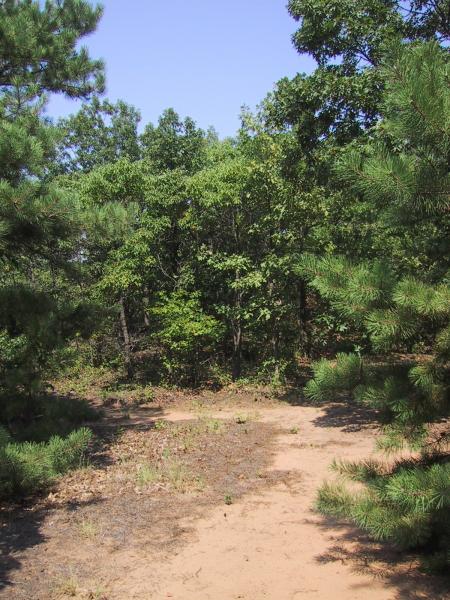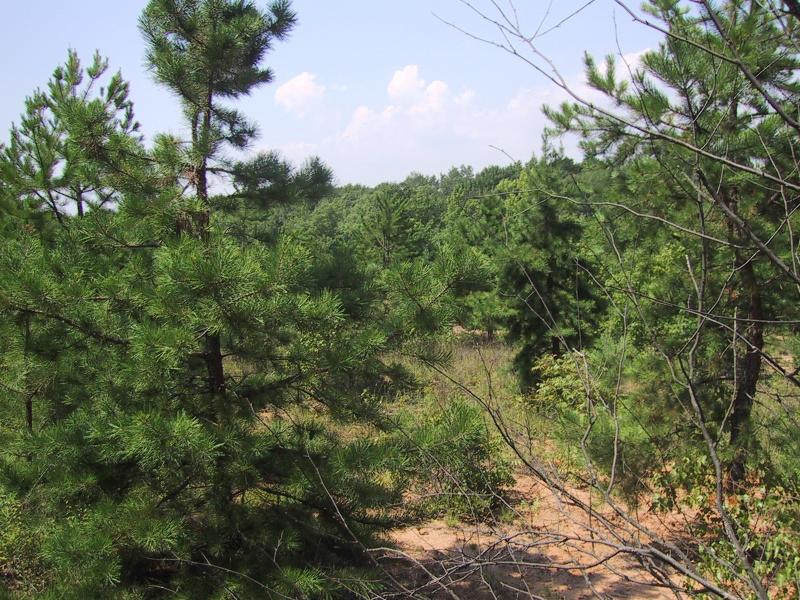Post Oak-Blackjack Oak Barrens
- System
- Terrestrial
- Subsystem
- Barrens And Woodlands
- State Protection
- Not Listed
Not listed or protected by New York State.
- Federal Protection
- Not Listed
- State Conservation Status Rank
- S1
Critically Imperiled in New York - Especially vulnerable to disappearing from New York due to extreme rarity or other factors; typically 5 or fewer populations or locations in New York, very few individuals, very restricted range, very few remaining acres (or miles of stream), and/or very steep declines.
- Global Conservation Status Rank
- G2G3
Imperiled or Vulnerable globally - At high or moderate risk of extinction due to rarity or other factors; typically 80 or fewer populations or locations in the world, few individuals, restricted range, few remaining acres (or miles of stream), and/or recent and widespread declines. More information is needed to assign either G2 or G3.
Summary
Did you know?
Post oak-blackjack oak barrens is a globally rare community that, in New York, is only found on Staten Island. Post oak wood is close grained, hard, and does not easily rot, so it is used widely for fenceposts, hence its name. It has also been used for railroad ties, construction timbers, and fuel.
State Ranking Justification
There are an estimated 10 extant occurrences statewide. Our currently documented occurrence has good viability and is protected on public conservation land. Currently this community is known only from the North Atlantic Coast ecoregion in Richmond County on Staten Island. The acreage, extent, and condition of post oak-blackjack oak barrens in New York are declining somewhat rapidly. They are threatened by exotic species invasion, development, and recreational pressures.
Short-term Trends
The acreage, extent, and condition of post oak-blackjack oak barrens in New York are declining somewhat rapidly, primarily due to displacement from urban and suburban development and exotic species invasion.
Long-term Trends
The number, extent, and viability of post oak-blackjack oak barrens in New York are suspected to have declined substantially over the long-term. These declines are likely correlated with development and associated changes in landscape connectivity.
Conservation and Management
Threats
Establishment and spread of invasive exotic species is a primary threat to this community. While the core of the documented occurrence is essentially free of exotics, the following species are present in adjacent communities: common reed (Phragmites australis), multiflora rose (Rosa multiflora), Japanese honeysuckle (Lonicera japonica), and coltsfoot (Tussilago farfara). Additional threats include displacement of this community by development and increased use by park visitors, which would very likely cause erosion and trampling of the vegetation in these dry sandy environments. Fire supression is another possible threat.
Conservation Strategies and Management Practices
Monitor the abundance of invasive species in this community and, as needed, control their encroachment. Restore and replicate the natural fire regime, as appropriate.
Development and Mitigation Considerations
Soils are very thin in and around this community and the effect of clearing and construction on soil retention and erosion must be considered during any development activities. Similarly, these soils are acidic and nutrient-poor and any soil enrichment activities (septic leach fields, fertilized lawns and golf courses) have a high probability of altering community structure and function. The open structure of this community is maintained by fire, which may present a fire hazard to existing and proposed development. Unprotected structures located within or near this community are likely to be more susceptible to damage from fire.
Inventory Needs
The identity and rank of all leads needs to be assessed, including Bethal Church Barrens, vicinity of Hyland Boulevard and Bedell Avenue, a large open space lying to the north of Mount Loretto Boys Home and west of Sharrot Avenue, Half Hollow Hills, Sweet Hollow Woods, and a reported oak woodland that could be a related community type at Caleb Smith Preserve. More occurrences may be discovered by reviewing locations for blackjack oak (Quercus marilandica) in the New York Natural Heritage Program rare plant element files. More occurrences may also be discovered by reviewing existing pitch pine-oak-heath woodland, pitch pine-scrub oak barrens, and successional maritme forest occurrences for areas dominated by blackjack oak.
Research Needs
Documentation of the natural fire regime of this community is needed.
Rare Species
Range
New York State Distribution
Currently this community is known only from the North Atlantic Coast ecoregion in Richmond County on Staten Island. The community may also occur on western Long Island and along the lower Hudson River.
Global Distribution
Restricted to the range of blackjack oak (Quercus marilandica) and post oak (Quercus stellata). Not expected in New England; New York is likely to be the northeastern limit. The community is currently known from Staten Island, New York, and is suspected to occur in New Jersey (NatureServe 2009).
Best Places to See
- Clay Pit Ponds State Park Preserve (Richmond County)
Identification Comments
General Description
Open barrens on upper slopes and low ridges characterized by a stunted canopy with a sparse heath and grass ground cover growing in very dry, deep, exposed sand overlying a clay subsoil. This community may be adapted to periodic fires; the fire regime has not been documented.
Characters Most Useful for Identification
Characteristic species include stunted individuals of post oak (Quercus stellata), scarlet oak (Q. coccinea), and blackjack oak (Q. marilandica). Other trees at low cover include white oak (Q. alba), black oak (Q. velutina), sassafras (Sassafras albidum), American chestnut (Castanea dentata), gray birch (Betula populifolia), red maple (Acer rubrum), pitch pine (Pinus rigida), and black gum (Nyssa sylvatica). The shrub layer includes sapling canopy trees along with blueberries (Vaccinium corymbosum, V. pallidum), and black huckleberry (Gaylussacia baccata). Characteristic vines are carrion flower (Smilax herbacea) and greenbrier (S. glauca). The herb layer has low percent cover of old field toadflax (Linaria canadensis), bracken fern (Pteridium aquilinum), bastard toadflax (Comandra umbellata), switch grass (Panicum virgatum), little bluestem (Schizachyrium scoparium), gray goldenrod (Solidago nemoralis), and wild indigo (Baptisia tinctoria).
Elevation Range
Known examples of this community have been found at elevations between 40 feet and 60 feet.
Best Time to See
The fall colors in the heath shrub layer and the grasses in the herbaceous layer come alive in early fall within this natural community. In addition, since this community occurs on Staten Island, a haven for migrating landbirds, early spring (May) or fall (late September-early October) would be a great time to see these birds in a unique natural community.
Post Oak-Blackjack Oak Barrens Images
Classification
International Vegetation Classification Associations
This New York natural community encompasses all or part of the concept of the following International Vegetation Classification (IVC) natural community associations. These are often described at finer resolution than New York's natural communities. The IVC is developed and maintained by NatureServe.
- Post Oak - Sassafras / Cat Greenbrier Woodland (CEGL006372)
NatureServe Ecological Systems
This New York natural community falls into the following ecological system(s). Ecological systems are often described at a coarser resolution than New York's natural communities and tend to represent clusters of associations found in similar environments. The ecological systems project is developed and maintained by NatureServe.
- Northern Atlantic Coastal Plain Heathland and Grassland (CES203.895)
Characteristic Species
-
Trees > 5m
- Acer rubrum var. rubrum (common red maple)
- Betula populifolia (gray birch)
- Nyssa sylvatica (black-gum, sour-gum)
- Prunus serotina var. serotina (wild black cherry)
- Quercus coccinea (scarlet oak)
- Quercus marilandica var. marilandica (blackjack oak)
- Quercus stellata (post oak)
- Quercus velutina (black oak)
- Sassafras albidum (sassafras)
-
Shrubs 2 - 5m
- Betula populifolia (gray birch)
-
Shrubs < 2m
- Gaylussacia baccata (black huckleberry)
- Quercus velutina (black oak)
- Sassafras albidum (sassafras)
- Vaccinium pallidum (hillside blueberry)
-
Vines
- Smilax glauca (white-leaved greenbrier)
- Smilax rotundifolia (common greenbrier)
-
Herbs
- Agrostis perennans (autumn bent)
- Andropogon virginicus
- Artemisia vulgaris (mugwort)
- Panicum virgatum (switch grass)
- Solidago nemoralis ssp. nemoralis (gray goldenrod)
Similar Ecological Communities
- Pitch pine-oak-heath woodland
(guide)
Pitch pine-oak-heath woodlands are characterized by an open canopy of pitch pine and white oak with scrub oaks (Quercus ilicifolia, Q. prinoides) dominating the shrub layer. Post oak-blackjack oak barrens may have a small component of pitch pine, but are dominated by stunted post oak, scarlet oak, and blackjack oak.
- Pitch pine-scrub oak barrens
(guide)
Pitch pine-scrub oak barrens are strongly dominated by pitch pine with scrub oaks and heath species in the somewhat dense shrub layer, whereas post oak-blackjack oak barrens are characterized by post oak, scarlet oak, and blackjack oak in the open canopy and sparse shrub and herb cover.
Vegetation
Percent cover
This figure helps visualize the structure and "look" or "feel" of a typical Post Oak-Blackjack Oak Barrens. Each bar represents the amount of "coverage" for all the species growing at that height. Because layers overlap (shrubs may grow under trees, for example), the shaded regions can add up to more than 100%.
Additional Resources
References
Anderson, M., P. Bourgeron, M. T. Bryer, R. Crawford, L. Engelking, D. Faber-Langendoen, M. Gallyoun, K. Goodin, D.H. Grossman, S. Grossman, K. Metzler, K. D. Patterson, M. Pyne, M. REID, L. Sneddon and A. S. Weakley. 1998. International classification of ecological communities: terrestrial vegetation of the United States. Volume II. The National vegetation classification system: list of types. The Nature Conservancy, Arlington, VA.
Breden, Thomas. 1989. A preliminary natural community classification for New Jersey. in New Jersey's rare and endangered plants and animals, Karlin, E.F. (ed.). Institute for Environmental Studies, Ramapo College, Mahwah, New Jersey.
Edinger, G. J., D. J. Evans, S. Gebauer, T. G. Howard, D. M. Hunt, and A. M. Olivero (editors). 2014. Ecological Communities of New York State. Second Edition. A revised and expanded edition of Carol Reschke’s Ecological Communities of New York State. New York Natural Heritage Program, New York State Department of Environmental Conservation, Albany, NY. https://www.nynhp.org/ecological-communities/
Edinger, Gregory J., D.J. Evans, Shane Gebauer, Timothy G. Howard, David M. Hunt, and Adele M. Olivero (editors). 2002. Ecological Communities of New York State. Second Edition. A revised and expanded edition of Carol Reschke's Ecological Communities of New York State. (Draft for review). New York Natural Heritage Program, New York State Department of Environmental Conservation. Albany, NY. 136 pp.
Faber-Langendoen, D. (editor). 2001. Plant communities of the Midwest: Classification in an ecological context. Association for Biodiversity Information, Arlington, VA.
Fike, J. 1999. Terrestrial and Palustrine Plant Communities of Pennsylvania. Pennsylvania Natural Diversity Inventory, Harrisburg, PA.
Fleming, G.P., P.P. Couling, D.P. Walton, K.M. McCoy, and M.R. Parrish. 2001. The natural communities of Virginia: Classification of ecological community groups. First approximation. Natural Heritage Technical Report 01-1. Virginia Department of Conservation and Rercreation, Division of Natural Heritage, Richmond, VA.
NatureServe. 2009. NatureServe Explorer: An online encyclopedia of life [web application]. Version 7.1. NatureServe, Arlington, Virginia. Available http://www.natureserve.org/explorer. (Data last updated July 17, 2009)
New York Natural Heritage Program. 2024. New York Natural Heritage Program Databases. Albany, NY.
Reschke, Carol. 1990. Ecological communities of New York State. New York Natural Heritage Program, New York State Department of Environmental Conservation. Latham, NY. 96 pp. plus xi.
Robichaud-Collins, B. and K.H. Anderson. 1994. Plant Communities of New Jersey: A study in landscape diversity. Rutgers University Press, New Brunswick, New Jersey.
Shapiro, A.M. 1972. New York City's Last Frontier: Field trips on Staten Island. The Staten Island Institute of Arts and Sciences, Staten Island, New York.
Sneddon, L., M. Anderson, and J. Lundgren. 1998. International classification of ecological communities: terrestrial vegetation of the northeastern United States. July 1998 working draft. Unpublished report. The Nature Conservancy, Eastern Conservation Science and Natural Heritage ProgramS of the northeastern United States, Boston, MA. July 1998.
Links
About This Guide
This guide was authored by: Aissa Feldmann
Information for this guide was last updated on: December 13, 2023
Please cite this page as:
New York Natural Heritage Program. 2024.
Online Conservation Guide for
Post oak-blackjack oak barrens.
Available from: https://guides.nynhp.org/post-oak-blackjack-oak-barrens/.
Accessed July 27, 2024.



